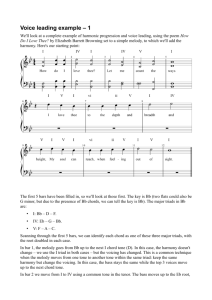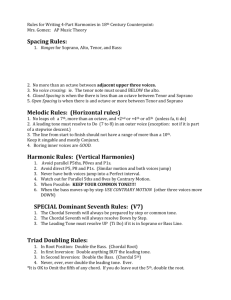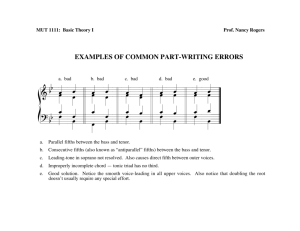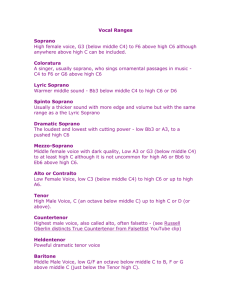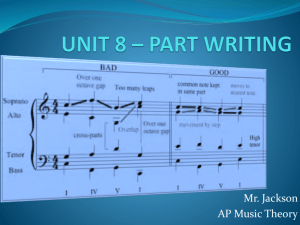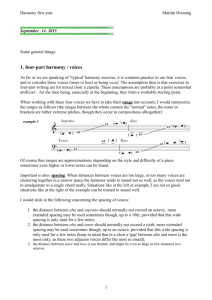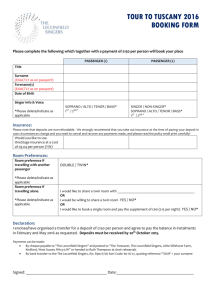Voicing - Glenn Rowe
advertisement
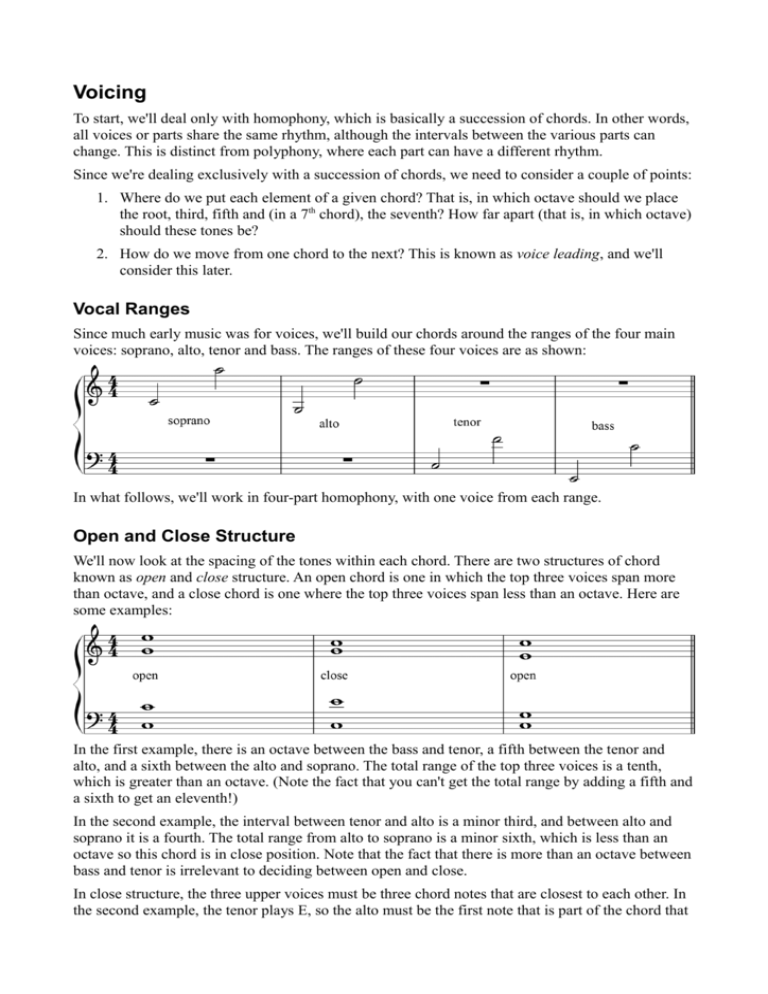
Voicing To start, we'll deal only with homophony, which is basically a succession of chords. In other words, all voices or parts share the same rhythm, although the intervals between the various parts can change. This is distinct from polyphony, where each part can have a different rhythm. Since we're dealing exclusively with a succession of chords, we need to consider a couple of points: 1. Where do we put each element of a given chord? That is, in which octave should we place the root, third, fifth and (in a 7th chord), the seventh? How far apart (that is, in which octave) should these tones be? 2. How do we move from one chord to the next? This is known as voice leading, and we'll consider this later. Vocal Ranges Since much early music was for voices, we'll build our chords around the ranges of the four main voices: soprano, alto, tenor and bass. The ranges of these four voices are as shown: In what follows, we'll work in four-part homophony, with one voice from each range. Open and Close Structure We'll now look at the spacing of the tones within each chord. There are two structures of chord known as open and close structure. An open chord is one in which the top three voices span more than octave, and a close chord is one where the top three voices span less than an octave. Here are some examples: In the first example, there is an octave between the bass and tenor, a fifth between the tenor and alto, and a sixth between the alto and soprano. The total range of the top three voices is a tenth, which is greater than an octave. (Note the fact that you can't get the total range by adding a fifth and a sixth to get an eleventh!) In the second example, the interval between tenor and alto is a minor third, and between alto and soprano it is a fourth. The total range from alto to soprano is a minor sixth, which is less than an octave so this chord is in close position. Note that the fact that there is more than an octave between bass and tenor is irrelevant to deciding between open and close. In close structure, the three upper voices must be three chord notes that are closest to each other. In the second example, the tenor plays E, so the alto must be the first note that is part of the chord that is above the E (which is G), and the soprano must be the first note above the G that is part of the chord (the upper C). We could also have given the tenor middle C, in which case the alto would be E and the soprano G. In the third example, the interval between tenor and soprano is an eleventh (a sixth from tenor to alto and a minor sixth from alto to soprano) so this is also an open chord. It is often a good idea to stick to either open or close structure for the duration of a phrase, but this isn't a strict rule; if a switch between structures gives you what you want, feel free to do it. Two Things to Avoid 1. Avoid gaps greater than an octave between adjacent voices in the top three voices. In the first example shown below there is a gap of an eleventh between the tenor G and the alto C. The reason for this is that a large gap detracts from the unity of the chord. However, a gap of more than an octave between bass and tenor is OK. Usually a gap up to a tenth is acceptable, although larger intervals are also possible. The gap shown in the second example above is a twelfth. 2. Voice crossing occurs when a note in an upper register is lower than a note in a lower register. In the third example above, the alto A is lower than the tenor middle C. This is bad since it's desirable to be able to follow each individual voice within the chord, and if the voices cross, it's hard to tell which note belongs to which voice. Doubling If we use a triad in four-part harmony, we have only 3 notes for 4 voices. To provide all 4 voices, we double one of the notes. Working with chords in root position (where the lowest note is the root of the key), we should double the root to provide the fourth voice. This is shown in the first example below: The bass and tenor both play a G, with the D (the fifth) in the alto and the B (third) in the soprano. If we are using a full 7th chord, then we simply write one note for each voice. In the second example, the bass is the root G, the tenor plays F# (seventh), the alto D (fifth) and the soprano B (third). However, it is quite common for a note to be dropped from a seventh chord; in such a case we need to double one of the remaining notes. The dropped note should be the fifth, since the root is always required for a chord in root position, the seventh is required to make the chord a 7th chord, and the third is required to determine if the chord is major or minor.
